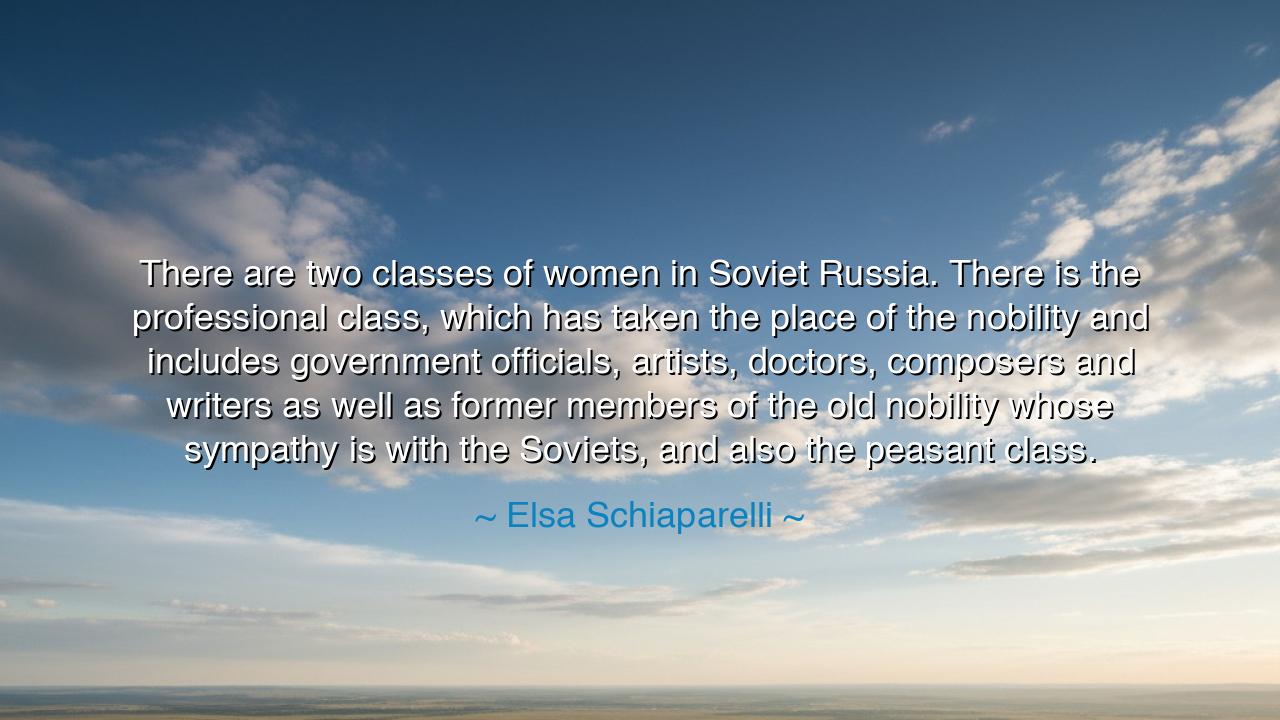
There are two classes of women in Soviet Russia. There is the
There are two classes of women in Soviet Russia. There is the professional class, which has taken the place of the nobility and includes government officials, artists, doctors, composers and writers as well as former members of the old nobility whose sympathy is with the Soviets, and also the peasant class.






Hear the words of Elsa Schiaparelli, the daring couturière who looked upon the upheavals of her century and spoke with sharp clarity: “There are two classes of women in Soviet Russia. There is the professional class, which has taken the place of the nobility and includes government officials, artists, doctors, composers and writers as well as former members of the old nobility whose sympathy is with the Soviets, and also the peasant class.” In these words she reflects upon a world reshaped by revolution, where old structures of power had fallen, and where women—long bound by tradition—now found themselves divided into new orders of being.
The meaning of her statement lies in its recognition of the profound transformation of society after the Russian Revolution. Where once there had been aristocrats and peasants, noblewomen and serfs, now the Soviet experiment sought to forge a new order. The professional class of women rose to prominence, not through inherited titles but through their service to the state—as doctors, teachers, writers, and bureaucrats. And yet, beneath them, the vast peasant class remained, tied still to the earth, to toil, and to survival. In this way, the Revolution promised equality but delivered division in another form, one bound not by lineage but by occupation and ideology.
The ancients knew such transformations. When Cleisthenes of Athens broke the power of the noble families and established democracy, new divisions emerged, not of blood but of civic role and responsibility. Likewise, the fall of the Russian nobility did not erase hierarchy, but merely recast it. The sympathy of certain former aristocrats with the Soviets, as Schiaparelli observed, allowed them to survive and even thrive, not as nobles but as professionals in the service of the new state. Thus the wheel of history turns: old classes fall, new ones rise, but divisions remain.
History bears witness in the life of Alexandra Kollontai, one of the first women in the Soviet government. She embodied the rise of the professional class, championing women’s rights, labor, and social reforms. Once unimaginable for women in tsarist Russia, her role showed the Revolution’s power to lift some women into positions of influence. Yet at the same time, countless peasant women remained bound to fields and kitchens, enduring hardships as severe as before. Here we see Schiaparelli’s truth: the Soviet vision promised transformation for all, but in practice, two distinct classes of women persisted.
The lesson is sobering. Even in times of great upheaval, when old hierarchies collapse and new orders are proclaimed, divisions among people remain. Names and forms may change—nobility may give way to professionals, serfs to peasants, aristocrats to officials—but the structure of society still separates. True equality cannot be declared by decree alone; it must be cultivated in the heart of a people, lived out in daily justice and compassion. Without this, the same walls will rise again, merely with different names carved upon them.
Practical action follows: when you look upon your own world, do not be deceived by words alone. Ask: Has the change touched only the names of the classes, or has it touched the lives of the people? Seek out those still bound to the bottom, those who labor unseen, and bring them into the circle of opportunity. Celebrate progress, but never ignore those left behind. In your own life, let justice and sympathy guide your actions, so that the bonds of division are not simply redrawn, but truly dissolved.
So let Schiaparelli’s words endure as a reminder of history’s cycles. Two classes of women in Soviet Russia—the professionals and the peasants—mirror the endless tension between power and labor, between privilege and survival. Let us not grow complacent, imagining that a change in name or ruler has ended division. Instead, let us strive for the deeper work: to build societies where worth is not measured by class, where women and men alike rise not by sympathy with power, but by the fullness of their humanity. For only then will the old chains of division be truly broken.






AAdministratorAdministrator
Welcome, honored guests. Please leave a comment, we will respond soon